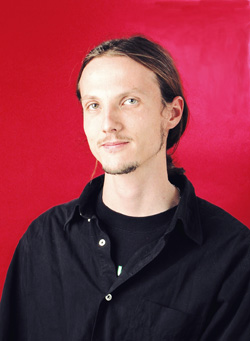Dr. Sebastien Guenneau
The NewScientist article Invisibility cloaks could take sting out of tsunamis said
“Invisibility cloaks that are able to steer light around two dimensional objects have become reality in the last few years. But the first real-world application of the theories that made them possible could be in hiding vulnerable coastlines and offshore platforms from destructive tsunamis.‘Basically, the cloak behaves like a whirlpool,’ says Sebastian Guenneau at the University of Liverpool, UK, and a member of Enoch’s team. ‘The further you go into the whirlpool, the faster you rotate.’
The spinning rate increases close to the cloak’s centre where the concentric corridors are narrower, making the forces greater, he explains.
As the water whizzes around the cloak, the waves are flung out again along the radial corridors. ‘If you imagine water entering the cloak from the north, some leaves the cloak to the east, and some leaves to the west, but most is thrown out at the south,’ says Guenneau.
The waves exiting the cloak travel as if they have not been disturbed at all, he says.”
Sebastien Guenneau, Ph.D. is Lecturer in Applied Mathematics, Department of Mathematical Sciences, University of Liverpool.
His research interests include:
I. Homogenization of composite micro-structures
Homogenization theory is a branch of convex analysis devoted to the
study of elliptic differential operators with fast oscillating periodic
coefficients. The physical outcome lies in so-called effective transport
properties of waves propagating at low frequencies within
micro-structured materials.
In the course of his Ph.D., he has developed new asymptotic tools, in order to derive the effective properties of quasi-crystals (e.g. Penrose tilings), including L2 error estimates controlled by an irrational parameter alpha (characterizing the quasi-periodicity): the error in 1D fluctuates between the periodic and random cases, depending on whether or note alpha can be easily approximated by rationals. The 2D and 3D corrector type results are still open cases (need of probabilistic approach for series estimates).
Also of interest are high-order asymptotic expansions for periodic, quasi-periodic, and stochastic media (analysis of resonant frequencies) with the “two-scale convergence” method (based on a variational approach with fast oscillating test functions). This method is well suited for singularly perturbed problems where classical homogenization fails (due to the presence of a small parameter sitting near high order derivatives in a PDE).
II. Analysis of thin-walled composite micro-structures
A challenging problem in the theory of composites is to imagine new micro-structures which will open up larger gaps or lead to counter intuitive physical phenomena (such as newly discovered Negative Refractive Index Materials where light travels in the wrong direction).
Direct applications lie in the improvement of optical communications (but also in futurist opto-electronic devices, audio-light filters, lasers, phasers, perfect lens). On a larger scale, one can also think of dumping elastic waves to protect cities form earthquakes. This leads to models of small defects and coating of inclusions including imperfect interfaces.
III. Mathematical models for waves in periodic media
It is well-known in spectral theory that the spectrum associated to the Schrodinger operator with a periodic potential consists of a succession of non-overlapping bands. But lots of exciting phenomena arise when one perturb slightly the potential (the bands may overlap, some eigen-states may appear in between the otherwise non-overlapping bands and so on).
The number (recently shown to be finite) and width of gaps is a difficult question to address. Some analogous phenomena occur in electromagnetism and elasticity. Physically, one is concerned with the propagation of waves in periodic structures, which may not be allowed to propagate within certain range of frequencies (at least in some crystalline directions). This is a non-trivial spectral problem.
The multipole method (Rayleigh method) is a technique which can be applied to static and dynamic problems of electromagnetism and elasticity for periodic composites. He has generalized this algorithm to analysis of waves propagating obliquely in arrays of cylindrical fibres (full vector problems). It enables him to reduce the spectral problem to an infinite set of algebraic equations.
IV. Mathematical models for “Negative Refractive Index” materials
This new research field has been initiated by studies led by John B. Pendry’s group at Imperial College in the mid 90’s. When one reverses the sign of the refractive index in the Snell-Descartes laws, light plays fancy games which leads to astonishing consequences such as lens resolution far beyond the wavelength limit (the perfect lens). The touchstone of a perfect refocusing for light is to put together alternating pairs of complementary media (refractive index of opposite signs): such slabs (of equal thickness) cancel each other out and thus the optical path vanishes!
Sebastien coauthored Foundations Of Photonic Crystal Fibres, Geometrical transformations and equivalent materials in computational electromagnetism, Achieving invisibility over a finite range of frequencies, Electromagnetic analysis of cylindrical cloaks of arbitrary cross-section, Bloch waves in periodic multi-layered acoustic waveguides, Finite element analysis of cylindrical invisibility cloaks of elliptical cross-section, Pure currents in foliated waveguides, Analytical and numerical analysis of lensing effect for linear surface water waves through a square array of close to touching rigid square cylinders, and Broadband Cylindrical Acoustic Cloak for Linear Surface Waves in a Fluid. He holds patent Elasto-Optical Dilatational Devices and Method of Establishing Same.
Sebastien earned his Ph.D. with the thesis “Physique des particules, physique mathematique et modelization” at the University of Aix-Marseille, France in 2001. He was elected to the London Mathematical Society in 2005.
Listen to his interview L’invisibilité Par Sébastien Guenneau. Read New Lens May Enable Ultrasound Advances, Scientists move a step closer to being able to make objects invisible, Invisibility cloak for water waves, and Acoustic “superlens” could mean finer ultrasound scans.
Read his LinkedIn profile.
